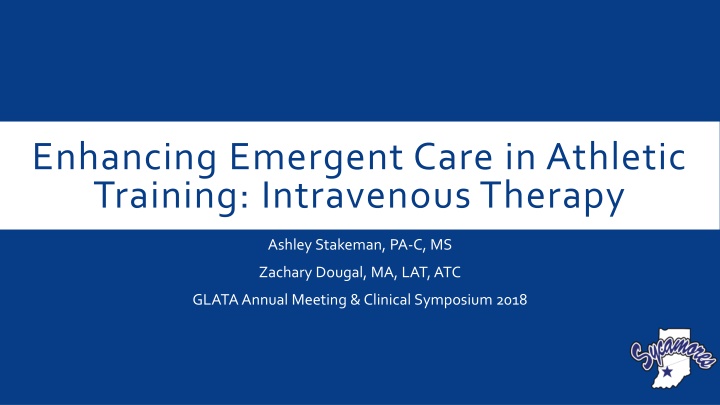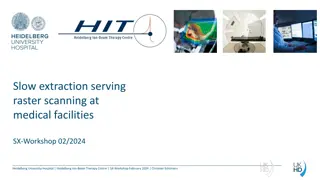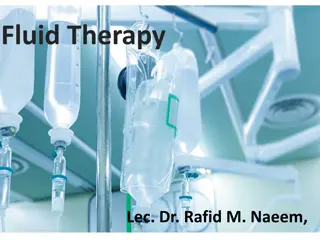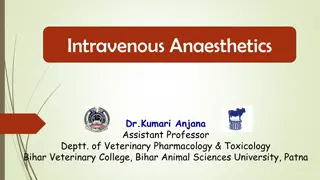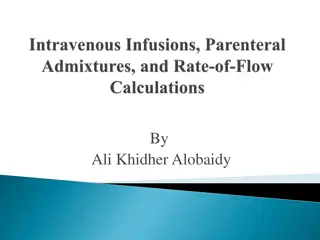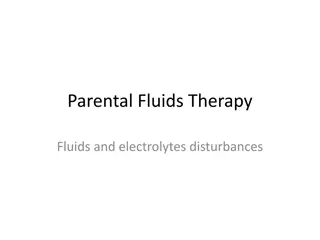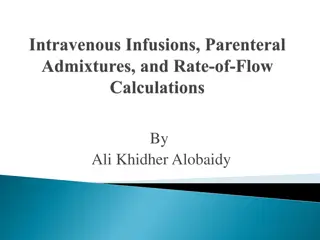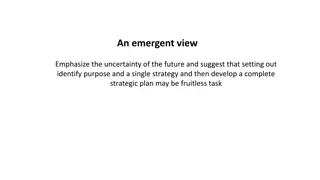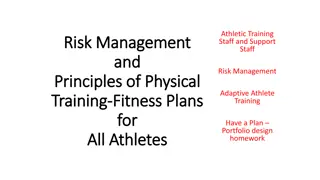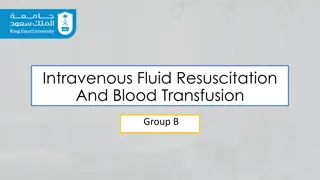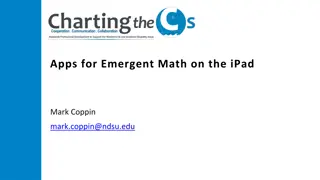Enhancing Emergent Care in Athletic Training: Intravenous Therapy Overview
This presentation discusses the role of intravenous (IV) therapy in athletic training, focusing on sport-related causes for IV fluid replacement, patient signs and symptoms necessitating IV therapy, proper application of angiocatheter insertion, and regulatory considerations. It highlights the importance of identifying dehydration, muscle cramps, and heat illnesses in athletes, along with evidence-based insights on IV fluid administration. The session also covers indications for IV fluid administration and regulations related to IV therapy in sports settings.
Download Presentation

Please find below an Image/Link to download the presentation.
The content on the website is provided AS IS for your information and personal use only. It may not be sold, licensed, or shared on other websites without obtaining consent from the author.If you encounter any issues during the download, it is possible that the publisher has removed the file from their server.
You are allowed to download the files provided on this website for personal or commercial use, subject to the condition that they are used lawfully. All files are the property of their respective owners.
The content on the website is provided AS IS for your information and personal use only. It may not be sold, licensed, or shared on other websites without obtaining consent from the author.
E N D
Presentation Transcript
Enhancing Emergent Care in Athletic Training: Intravenous Therapy Ashley Stakeman, PA-C, MS Zachary Dougal, MA, LAT, ATC GLATA Annual Meeting & Clinical Symposium 2018
Disclosure Statement No Conflict The views expressed in these slides and today s discussion are ours Our views may not be the same as the views of our colleagues Participants must use discretion when using the information contained in this presentation
Objectives Identify sport related causes for IV fluid replacement therapy Analyze patient signs and symptoms and synthesize results to determine the need for IV fluid replacement therapy Identify the needed supplies, and the use of each, for IV fluid replacement therapy Demonstrate proper application of angiocatheter insertion and connect to appropriate IV solution
Sport Related Causes Dehydration Inadequate pre-exercise fluid intake Exercise Associated Muscle Cramps Etiology of EAMC is multifaceted No high-level evidence suggests IV prehydration prevents EAMC 1-4 EAMC Treatment replace fluid and salt loses1,5 Exertional Heat Illnesses Prevention Proper pre-exercises fluid intake Treatment IV fluid administration may be needed if oral fluid intake is not tolerated
Evidence Related to IV Use IV fluid administration has an increased relative risk compared to oral rehydration1 Current evidence does not support the routine use of IV fluids for rehydration for otherwise healthy athletes that can tolerate oral fluids2,6-14 IV fluid administration should be used in cases of oral fluid intolerance1
Determining Need for IV Fluid Administration Clinical signs of dehydration Increased thirst Dark-colored urine Fatigue Dry skin Headache Indications for IV fluid administration Inability to tolerate oral rehydration
Regulations for IV Therapy World Doping Agency prohibits the routine use of IV fluids (>50 mL per 6 hours) in healthy individuals15 NCAA and most professional agencies in the US do not fall under World Doping Agency provision NCAA only has regulations for wrestling prohibited as a means of rehydration16
Legal Considerations Documentation of knowledge above entry-level CEU certificate from attendance today State practice act requirements If the AT is acting under the direction of a licensed team medical doctor, osteopath, podiatrist, or chiropractor, the AT is allowed a broader array of activities in which the AT may engage Indiana State Practice Act Physician privileging Should be specific to each of the healthcare organization s care delivery settings Standing Letter of Orders
Helpful videos How to Find a Vein https://www.youtube.com/watch?v=NkKNLBMq-C8 How to Tie a Tourniquet https://www.youtube.com/watch?v=RFncdUfaJNg
IV Placement IV (intravenous) cannulation is a technique in which a cannula is placed inside a vein to provide venous access. The purpose is to: Obtain a blood sample Administer Fluids Meds TPN Chemo Blood products
IV Access Devices Peripheral catheter Peripherally inserted central catheter (PICC line) Central line Jugular Subclavian Femoral Subcutaneous injection port
Needle Gauge Smaller the gauge, the larger the needle!
IV site assessment Site should be visually inspected and palpated every 2 hours IV site should be free of redness, swelling, tenderness IV dressing should be clean and secure For adults, change catheter and rotate site every 48-72 hours. Replace catheters inserted under emergency conditions within 24 hours.
Air Embolus (20mL-150mL air) Signs and Symptoms of Air Embolism include: Abrupt drop in blood pressure Weak, rapid pulse Cyanosis Chest Pain Immediate corrective action for suspected Air Embolism includes: Notify Supervisor and Physician immediately Immediately place patient on left side with feet elevated (this allows pulmonary artery to absorb small air bubbles) Administer O2 if necessary Preventive Measures to avoid Air Embolism includes: Clear all air from tubing before attaching it to the patient Monitor solution levels carefully and change bag before it becomes empty Frequently check to assure that all connections are secure
IV Fluids 3 Types of IV fluids: Hypertonic: any soln that has a higher osmotic pressure than another soln (draws fluid out of cell into ECF) Hypotonic: any soln that has a lower osmotic pressure than another soln (pushes fluid into the cell) Isotonic: any soln that has the same osmotic pressure than another soln (does not draw or push fluid into cell)
Normal Saline NS, 0.9% NaCL Isotonic soln (contains same amounts of Na and Cl found in plasma) Contains 90g of NaCl per 100mL of water Indicated for use in conjunction with blood transfusions and for restoring the loss of body fluids
Ringers Solution or Lactate Ringer s (LR) Isotonic Contains NaCl, KCl, CaCl, and Na lactate Indicated for use as the choice for burn patients, and in most cases of dehydration Recommended for supportive treatment of trauma
D5W 5% dextrose and water Isotonic (after administration and metabolism of the glucose; D5W becomes a hypotonic soln) Contains 5g of dextrose per 100mL of water Indicated for use as a calorie replacement soln and in cases where glucose is needed for metabolism purposes
Saline Lock Flush before and after each use Flush every shift Flush PRN
Fluid overload during IV therapy Pitting edema (1+-4+) Puffy eyelids Acute weight gain Elevated blood pressure Bounding pulse Dyspnea (usually first sign) Ascites or third spacing
Fluid Volume Deficit in IV therapy Dry Skin (cap refill > 3 sec) Elevated or subnormal temperature Thirst Dry mucus membranes Decreased urine output Soft sunken eyeballs Decrease tearing and salivating Hypotension
IV Placement How To Videos IV placement in the antecubital fossa https://www.youtube.com/watch?v=DHuOIcxJTIY IV placement in the dorsum of hand https://www.youtube.com/watch?v=Xms43IPHbwU
Supplies Needed Tourniquet Extension set/connector Cotton balls Saline flush 5 mL Gauze Saline bag Alcohol pads IV tubing set IV catheter (20 or 22 gauge) IV start kit Sharps container
Site Selection Factors to consider: Extensive scarring or healed burn areas should be avoided Avoid areas containing trauma IVs should not be placed on the same side as a mastectomy Avoid areas of hematoma Avoid placing an IV in an arm having a cannula, fistula, or vascular graft If patient is going to be transported to a facility for additional medical care, place the IV as distally as possible. Avoid areas where the vein bifurcates
IV Placement Steps 1. Use universal precautions for bloodborne pathogens 2. Tie tourniquet on upper arm 3. Palpate and locate a vein 4. Insert the needle into the vein and get flash of blood 5. Advance the catheter and withdraw the needle 6. Release the tourniquet 7. Flush the IV with normal saline 8. Attach the IV tubing 9. Anchor the IV at the catheter site
Thank You! Ashley.Stakeman@indstate.edu zdougal@sycamores.indstate.edu
References 1. Givan GV, Diehl JJ. Intravenous fluid use in athletes. Sports Health. 2012;4(4):333-339. 2. American College of Sports Medicine; Armstrong LE, Casa DJ, Millard- Stafford M, et al. Exertional heat illness during training and competition: ACSM position stand. Med Sci Sports Exerc. 2007;39(3):5560572 3. American College of Sports Medicine; Sawka MN, Burke LM, Eichner ER, Maughan RJ, Montain SJ, Stachenfeld NS. American College of Sports Medicine position stand: exercise and fluid replacement. Med Sci Sports Exerc. 2009,39(2):709-731. 4. Ganio MS, Casa DJ, Armstrong LE, Maresh CM. Evidence-based approach to lingering hydration questions. Clin J Sports Med. 2007;26(1):1-16. 5. Eichner ER. Heat Cramps in sport. Curr Sports Med Rep. 2008;7:178-179.
References 6. Casa DJ, Maresh CM, Armstrong LE, et al. Intravenous vs oral rehydration during a brief period: responses to subsequent exercise in heat. Med Sci Sports Exerc.2000;32(1):124-133. 7. Castellani JW, Maresh CM, Armstrong LE, et al. Intravenous vs oral rehydration: effect on subsequent heat stress. J Appl Physiol. 1997;82(3):799-807. 8. Deschamps A, Levy RD, Cosio MG, Marliss EB, Magder S. Effect of saline infusion on body temperature and endurance during heavy exercise. J Appl Physiol. 1989;66(6):2799-2804. 9. Hamilton MT, Gonzalez-Alsnso J, Montain SJ, Coyle EF. Fluid replacement and glucose infusion during exercise prevent cardiovascular drift. J Appl Physiol.1991;71(3):871-877. 10. Hostler D, Bednez JC, Kerin S, et al. Comparison of rehydration for rehabilitation of firefighters performing heavy exercise in thermal protective clothing: a report form the Fireground Rehab Evaluation (FIRE) trial. Prehosp Emerg Care. 2010;14(2):194- 201.
References 11. Hostler D, Gallagher M, Gross FL, et al. The effect of hyperhydration on physiological and perceived strain during treadmill exercise in personal protective equipment. Eur J Appl Physiol. 2009;105(4):607-613. 12. Kenefick RW, O Moore KM, Mahood NV, Castellani JW. Rapid IV versus oral rehydration: responses to subsequent exercise heat stress. Med Sci Sports Exerc. 2006;38(12):2125-2131. 13. Maresh CM, Herrera-Soto Ja, Armstrong LE, et al. Perceptual responses in the heat after brief intravenous versus oral rehydration. Med Sci Sports Exerc. 2001;33(6):1039-1045. 14. Piet van Rosendal S, Osborne MA, Fassett RG, Lancashire B, Coombes JS. Intravenous versus oral rehydration in athletes. Sports Med. 2010;40(4):327-346. Casa DJ, Maresh CM, Armstrong LE, et al. Intravenous versus oral rehydration during a brief period: responses to subsequent exercise in the heat. Med Sci Sports Exerc. 2000;32(1):124-133. 15. Casa DJ, Ganio MS, Lopez RM, McDermott BP, Armstrong LE, Maresh CM. Intravenous versus oral rehydration: physiological performance, and legal considerations. Curr Sports Med Rep. 2008;7(4):S41-S49. 16. NCAA Wrestling Committee. 2012 and 2013 wrestling major rules changes. http://fs.ncaa.org/Docs/rules/wrestling/2011/Rules_changes_for_2012_%2013.pdf
